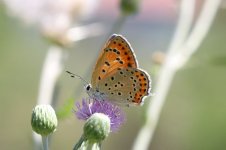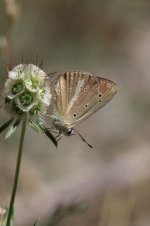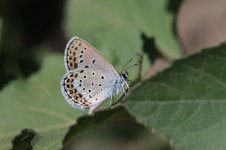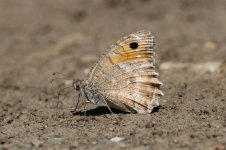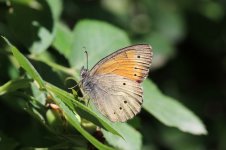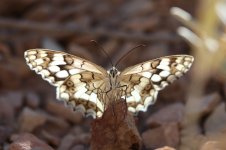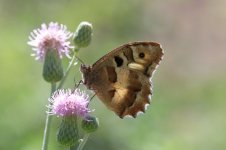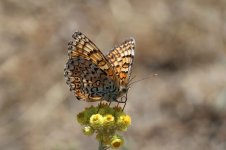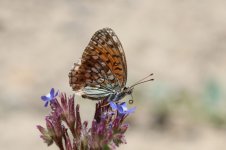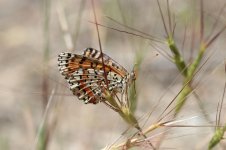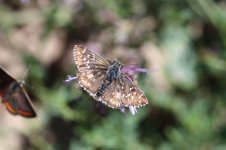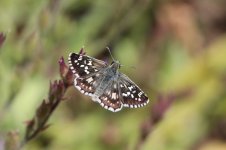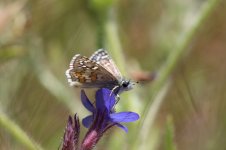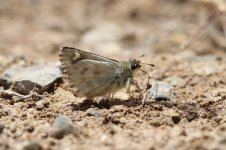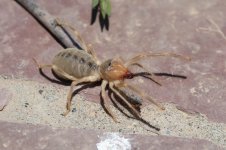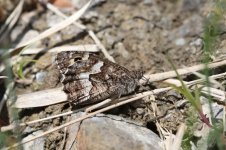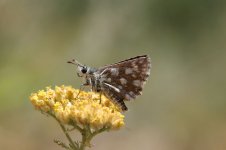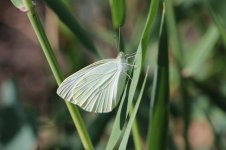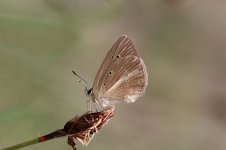
INTRODUCTION
Inspired by a trip report on BirdForum and following on from several birding trips to the neighbouring states of Georgia, Turkey and Iran, it was time to visit Armenia. The focus this time however was butterflies - in the varied habitats of the high Caucasian mountains, expanses of steppe and arid semi-deserts, a total of over 240 species of butterfly have been recorded in the country, many of which do not occur further west. In my ten-day trip, I would see approximately 125 of these. Naturally, though most of my attention was dedicated to butterflies, birding also figured prominently, not least at the superb Armash Fish Pools (White-tailed Lapwing, Blue-cheeked Bee-eater), at Mount Aragats (Radde's Accentor, White-throated Robin, etc) and at Vedi Gorge and Novarank (Grey-necked Bunting, Eastern Rock Nuthatch, Persian Wheatear, etc).
BUTTERFLY LOCATIONS
In terms of butterflies, Armenia is a relatively unknown country to the outside world, little is available online and scant information exists for the visiting butterfly enthusiast. In determining where to visit and to work out an itinerary, I used three main sources:
As a result of this, my route was an approximate loop from Yerevan firstly southward to areas around Khosrov Reserve, Armash Fish Pools and Noravank Gorge, then northeast past Lake Sevan and north up to the beech forests at Acharkut. From here, I crossed westward over the Jajur Mountain Pass and then back south visiting the superb slopes of Mount Aragats and Mount Gndasar. Due to rain on my first visit to Acharkut, I revisited this site and Jajur at the end of the trip too.
In an attempt to partially address the lack of information available, I include here basic details and coordinates for the main sites visited, plus the number of species I saw at each (full details of the species are in the later day log and species lists):
Vedi Gorge (39.9392, 44.7076)
Primarily a birding locality (Grey-necked Bunting, etc), but also provides possibility for arid country species. Saadi’s Heath and Christoph’s Blue here, but was too early in the morning for many butterflies.
Khosrov (three productive areas 39.9796, 44.8794 / 39.9627, 44.8618 / 39.9473, 44.8883)
Reserve not accessible without permit and guide. Surrounding areas fairly arid, full of Hermits, assorted skippers and Ripart’s Anomalous Blues. Best numbers of butterflies along watercourses, as in coordinates above. As a dry country locality, only 36 species seen.
Amaghou Steppe (39.6793, 45.2056)
Excellent roadside location, high altitude steppe rich in flowers. Incredible numbers and varieties of butterflies, especially puddling blues and skippers. 29 species seen in a couple of hours.
Noravank Gorge (39.6823, 45.2350)
Below the famous monastery, a small trail through riverine woodland and open scrub. High diversity and abundance of butterflies, including puddling blues at the beginning of the trail, a variety of hairstreaks and many others. 39 species seen.
Vardenyats Pass (northside 39.9336, 45.2323 / plateau 40.006, 45.2343)
Steep wet slopes on the south side, supporting a good mix of frillaries and heaths, plus Clouded Apollo. Extensive grasslands on the plateau not so productive on my brief visit, though Greek Clouded Yellow present. Brief visit, 24 species seen.
Arakelots Beech Forest (41.032, 45.0697)
Lush deciduous forest and open meadows, many butterflies. A species mix more similar to parts of central Europe, including many Hungarian Gliders and Great banded Graylings. 54 species seen, including many not seen elsewhere in Armenia.
Jajur Pass (grasslands and pine 40.8651, 43.9992/ mountain valley 40.8728, 43.9939)
High steppe grasslands, mountain valley and pine forest. Many species present, including localised Lederer’s Heath and both Gavarnie Blue and Alcon Blue. In total, 49 species seen.
Amberd Valley (40.3599, 44.2506)
Riverine vegetation and lush vegetation in an otherwise arid gorge. Massive numbers of butterflies, both puddling along the track and attracted to the many flowers. Whole valley for several kilometres was phenomenal, though access may be restricted beyond a gate a half kilometre in (was prevented from entering on a return visit). 58 species seen.
Mount Aragats (upward from 40.3996, 44.2509)
With habitats including dry and damp meadows at various altitudes, lush vegetated valleys and high altitude grassland, a very good range of species present. Highest numbers of species were found in a steep valley on the Amberd Castle road, but many good localities found by random stops. Low number of butterflies at the highest altitude (around Lake Kari), but does support Bowden's White, a species found nowhere else in Armenia. In total, 47 species seen.
Mount Gnishik (39.8299, 45.1537)
High altitude mountain steppe, excellent mix of butterflies, many puddling and attracted to abundant flowers. Access via steep rocky track, high clearance/4WD required. 52 species seen.
Inspired by a trip report on BirdForum and following on from several birding trips to the neighbouring states of Georgia, Turkey and Iran, it was time to visit Armenia. The focus this time however was butterflies - in the varied habitats of the high Caucasian mountains, expanses of steppe and arid semi-deserts, a total of over 240 species of butterfly have been recorded in the country, many of which do not occur further west. In my ten-day trip, I would see approximately 125 of these. Naturally, though most of my attention was dedicated to butterflies, birding also figured prominently, not least at the superb Armash Fish Pools (White-tailed Lapwing, Blue-cheeked Bee-eater), at Mount Aragats (Radde's Accentor, White-throated Robin, etc) and at Vedi Gorge and Novarank (Grey-necked Bunting, Eastern Rock Nuthatch, Persian Wheatear, etc).
BUTTERFLY LOCATIONS
In terms of butterflies, Armenia is a relatively unknown country to the outside world, little is available online and scant information exists for the visiting butterfly enthusiast. In determining where to visit and to work out an itinerary, I used three main sources:
- Armenian butterfly conservation website (www.butterfly-conservation-armenia.org) - this includes a section on suggested localities, with basic habitat information, likely day totals at each and lists of some of the potential species.
- Naturetrek website - this company has run successful butterfly trips to Armenia for a number of years and includes trip reports for several recent years.
- Bird reports (eg from Cloudbirders) - the rationale here was visit the key birding areas and the butterflies would surely follow.
As a result of this, my route was an approximate loop from Yerevan firstly southward to areas around Khosrov Reserve, Armash Fish Pools and Noravank Gorge, then northeast past Lake Sevan and north up to the beech forests at Acharkut. From here, I crossed westward over the Jajur Mountain Pass and then back south visiting the superb slopes of Mount Aragats and Mount Gndasar. Due to rain on my first visit to Acharkut, I revisited this site and Jajur at the end of the trip too.
In an attempt to partially address the lack of information available, I include here basic details and coordinates for the main sites visited, plus the number of species I saw at each (full details of the species are in the later day log and species lists):
Vedi Gorge (39.9392, 44.7076)
Primarily a birding locality (Grey-necked Bunting, etc), but also provides possibility for arid country species. Saadi’s Heath and Christoph’s Blue here, but was too early in the morning for many butterflies.
Khosrov (three productive areas 39.9796, 44.8794 / 39.9627, 44.8618 / 39.9473, 44.8883)
Reserve not accessible without permit and guide. Surrounding areas fairly arid, full of Hermits, assorted skippers and Ripart’s Anomalous Blues. Best numbers of butterflies along watercourses, as in coordinates above. As a dry country locality, only 36 species seen.
Amaghou Steppe (39.6793, 45.2056)
Excellent roadside location, high altitude steppe rich in flowers. Incredible numbers and varieties of butterflies, especially puddling blues and skippers. 29 species seen in a couple of hours.
Noravank Gorge (39.6823, 45.2350)
Below the famous monastery, a small trail through riverine woodland and open scrub. High diversity and abundance of butterflies, including puddling blues at the beginning of the trail, a variety of hairstreaks and many others. 39 species seen.
Vardenyats Pass (northside 39.9336, 45.2323 / plateau 40.006, 45.2343)
Steep wet slopes on the south side, supporting a good mix of frillaries and heaths, plus Clouded Apollo. Extensive grasslands on the plateau not so productive on my brief visit, though Greek Clouded Yellow present. Brief visit, 24 species seen.
Arakelots Beech Forest (41.032, 45.0697)
Lush deciduous forest and open meadows, many butterflies. A species mix more similar to parts of central Europe, including many Hungarian Gliders and Great banded Graylings. 54 species seen, including many not seen elsewhere in Armenia.
Jajur Pass (grasslands and pine 40.8651, 43.9992/ mountain valley 40.8728, 43.9939)
High steppe grasslands, mountain valley and pine forest. Many species present, including localised Lederer’s Heath and both Gavarnie Blue and Alcon Blue. In total, 49 species seen.
Amberd Valley (40.3599, 44.2506)
Riverine vegetation and lush vegetation in an otherwise arid gorge. Massive numbers of butterflies, both puddling along the track and attracted to the many flowers. Whole valley for several kilometres was phenomenal, though access may be restricted beyond a gate a half kilometre in (was prevented from entering on a return visit). 58 species seen.
Mount Aragats (upward from 40.3996, 44.2509)
With habitats including dry and damp meadows at various altitudes, lush vegetated valleys and high altitude grassland, a very good range of species present. Highest numbers of species were found in a steep valley on the Amberd Castle road, but many good localities found by random stops. Low number of butterflies at the highest altitude (around Lake Kari), but does support Bowden's White, a species found nowhere else in Armenia. In total, 47 species seen.
Mount Gnishik (39.8299, 45.1537)
High altitude mountain steppe, excellent mix of butterflies, many puddling and attracted to abundant flowers. Access via steep rocky track, high clearance/4WD required. 52 species seen.
Last edited:






